
views
Setting up the Game

Use a 52-card deck and learn the values of the cards and suits. Deuces are the highest ranking cards of all, and the value of the rest of the cards runs in numerical order from lowest to highest: 3, 4, 5, 6, 7, 8, 9, jack, queen, king, ace, 2. The suit rankings from lowest to highest: spades, clubs, diamonds, and hearts. Remove any jokers from the deck before you start the game. In Tien Len, the 2 of hearts will always outrank the 2 of any other suit. The numerical value always comes before the suit value, so an 8 of spades will always be higher than a 7 of hearts. The suit value is only used to determine the highest card if the same numerical-value cards are played. For example, if two 7s are played, the 7 with the highest suit value trumps the other 7.

Play the game with 4 people. Sit around a table so the cards can be placed in the center, easily visible to all the players. If someone is new to playing Tien Len, it will be helpful to have the rules and a list of legal combinations printed out for them to reference during the game. The legal combinations are the types of groupings of cards that you’re allowed to play during any given hand.

Decide who deals by cutting the deck to see who gets the highest card. Cut the deck by setting it on the table, face down. Separate the deck by hand wherever it naturally breaks and look at the number on the bottom card. Have each player do this to see who will shuffle and deal. You could also decide who deals in many other ways. The person who either lost or won the previous game could be the dealer, it could be the person who has a birthday coming up next, or the person who has the smallest shoe size.

Have the dealer shuffle and deal 13 cards face down for each player. Thoroughly shuffle the cards so that any combinations from previous games are no longer in order. Deal one card at a time, going around the table counterclockwise, until each player has 13 cards (the entire deck for a 4-player game).Tip: If you want to play with more or less than 3 people, just make sure that each player gets 13 cards and leave whatever cards are leftover in a discard pile off to the side. For more than 4 people, you will need an additional deck of cards.
Playing the First Round

Start the first hand with a legal combination if you have the 3 of spades. The 3 of spades always starts the game, as it is the lowest ranking card in the entire deck. To begin the game, use one of these legal combinations in conjunction with the 3 of spades: Solo: 1 card. For example, you could simply play the 3 of spades on its own. In other subsequent hands, you can play a solo card of any value. Doubles: 2 cards of the same value, like 2 3s. Triples: 3 cards of the same value, like 3 3s. Quads: 4 cards of the same value, like 4 3s. Runs: this is also called a straight; it consists of 3 or more cards that run in sequence. These cards don’t have to match suit. Runs cannot contain 2s. For example, you could play the 3 of spades, 4 of hearts, and 5 of spades. Double runs: 2 sets of 3 or more cards that have the same straight-number sequence. The cards don’t have to match in suit and the runs cannot contain 2s. For example, 3 of spades, 3 of hearts, 4 of clubs, 4 of spades, 5 of hearts, and 5 of diamonds would be a double run.Tip: In some variations of the game, you can win automatically if you have all 4 deuces. Decide with your friends beforehand if you’ll honor this rule.
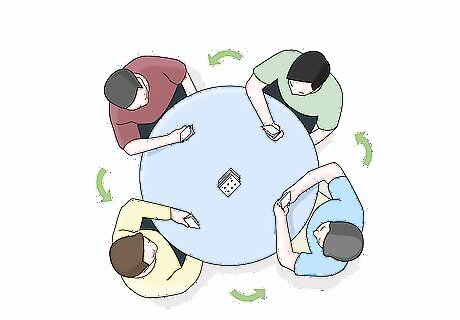
Take turns counterclockwise trying to beat the previous combination. To beat a combination, a player must lay down the same number of cards and the same type of combination. For example, if there is a double-card combination of 4s laid down, you can beat this combination by laying down a double-card combination with face values that are higher than 4. In another example, let’s say there is a 4-card run of a 5, 6, 7, and 8. You can beat this run by laying down another 4-card run as long as the highest number will be greater than the 8 that was laid down, either in numerical value or in suit value.
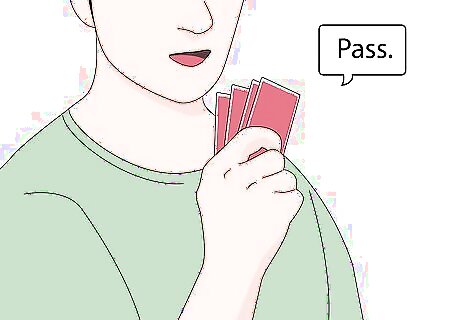
Pass if you can’t beat the combination or if you don’t want to play. If you can’t match the combination or if your cards aren’t high enough to beat what is on the table, you have to pass your turn. If you simply want to save your cards to use at a later time, you can also pass. Once you pass, you cannot resume playing until a new combination has been laid down by someone else.
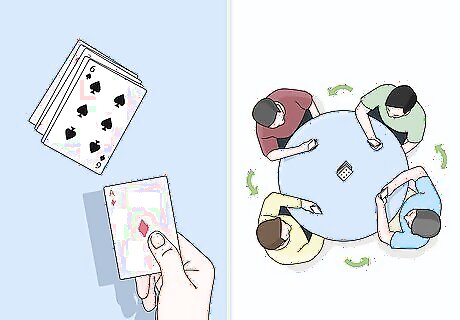
Continue playing until no one can beat the combination on the table. Keep taking turns counterclockwise until 3 people have passed their turn, signaling that no one can beat what’s on the table. Remove the cards from the center of the table and put them off to the side in a discard pile. You won’t actually use those cards from the discard pile again during the game.
Using Bombs and Chops

Play a “bomb” or “chop” to beat a combination in an unconventional way. These strategies are mainly used to beat combinations that include 2s since those are the highest valued cards. Once a bomb or chop has been played, that new combination is what will be played off of moving forward in the hand. A quad combination used to beat deuces is generally called a “bomb.” A sequence used to beat deuces is usually called a “chop.”

Beat a solo 2 with a quad combination or a 3-card double run. For example, a solo 2 could be beaten by 4 queens or even by 4 3s. A solo 2 could also be beaten by 5, 5, 6, 6, 7, and 7, or some other similar combination. The values of the cards played don’t matter in this case—just the actual combination matters. Whatever is used to beat the solo 2 is the new combination that the next player will need to trump. For example, if a solo 2 is beaten by 4 5s, the next player will need to play a quad combination with a card value that is higher than 5.
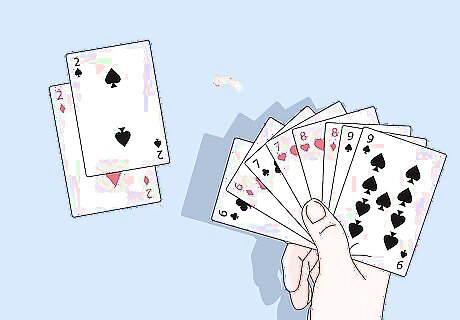
Lay down a 4-card double run to beat a pair of 2s. A 4-card double run will consist of 8 cards in total. For example, 6, 6, 7, 7, 8, 8, 9, and 9 would be a 4-card double run. Remember, the suits do not have to match when you play runs. A 4-card double run can also beat any quad combination or 3-card double run.

Play a 5-card double run to beat 3 2s. The only way to beat 3 2s is to use 10 cards to play 2 5-card runs, like 3, 3, 4, 4, 5, 5, 6, 6, 7, and 7. The suits do not matter, but the numbers have to match up from one run to another. There is no way to beat 4 2s. Having 4 2s automatically wins the game for the player they belong to.
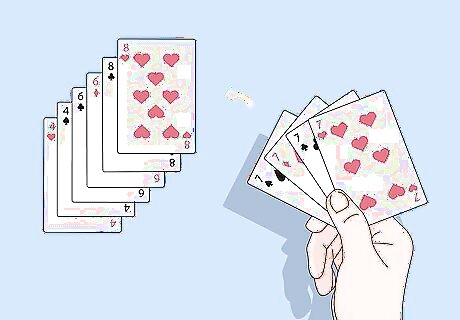
Trump a 3-card double run with a quad combination. For example, if someone plays a double run consisting of any arrangement of cards, you could play 4 3s and beat their combination. Your quad combination can hold any value and still beat the 3-card double run. The quad combination will then be what the next player has to beat on their turn to keep the hand going.
Ending the Game

Begin the next hand if you played the last laid highest combination. The person who laid the combination that trumped everyone else’s cards gets to lead the next round. That person leads by laying down another legal combination, and thus the game continues.Tip: At any point during the game, you can ask your opponents how many cards they have left in their hands. Each player has to give you a truthful answer.

Lay down your final legal combination to “win” the game. The first person to completely empty their hand of all their cards is the official winner. If you want, though, the remaining players can continue to play to determine who comes in 2nd, 3rd, and 4th places. Part of the fun of Tien Len is that no scoring is required, so literally all you need to play the game is a deck of cards and some friends. In some variations of the game, the winner of a hand of Tien Len will lead the next game, rather than the person who has the 3 of spades.

Win immediately if your hand contains an “auto win” sequence. These are optional variations to the game, so decide with your friends beforehand if you want to honor any of them. If you decide you want to do so, check your hand when it’s first dealt to see if you are an automatic winner: 4 deuces 6 sets of doubles Dragon series, meaning you have 3, 4, 5, 6, 7, 8, 9, 10, jack, queen, king, ace, 2. The suits don’t have to match. 13 red or black cards.

Play for money to turn Tien Len into a betting game. In many variations of Tien Len, it’s common for the players to bet real money on whether or not they will be the ultimate loser of the game. Instead of the winnings going to the first person who lays down all their cards, the last person holding cards has to pay out a specified amount of money to the other 3 players. Or, you could also play a variation where the 3rd and 4th place players pay money to the 1st and 2nd place players, making sure that the 1st place player always wins the most money. For example, if the agreed-upon bet is $25, at the end of the game the loser will pay each individual player $25, for a total of $75 lost. You could get creative with the betting and do something like the loser has to buy everyone a round of drinks or has to pay for pizza to be delivered. Make it fun and feel free to think outside the box! In some variations, the 3rd and 4th place players have to give their 2 highest-ranking cards to the 1st and 2nd place players in the next game.




















Comments
0 comment